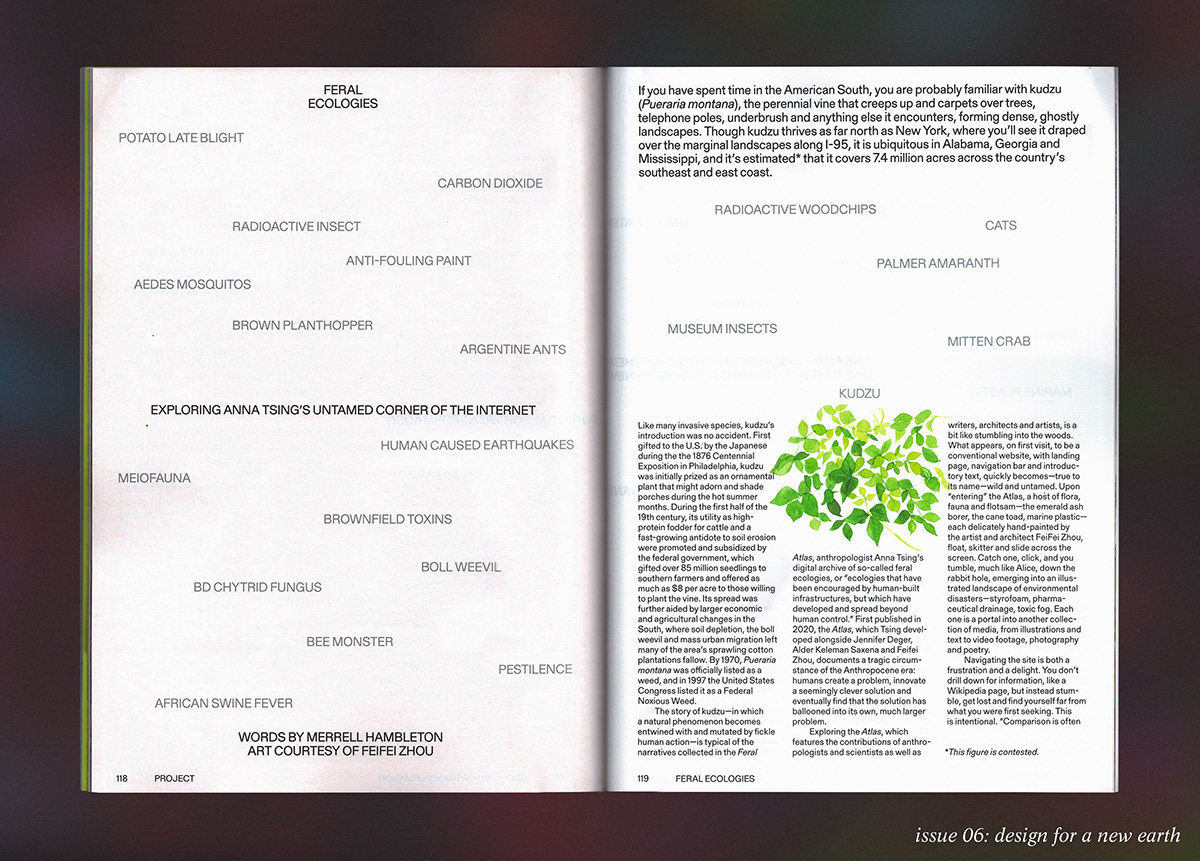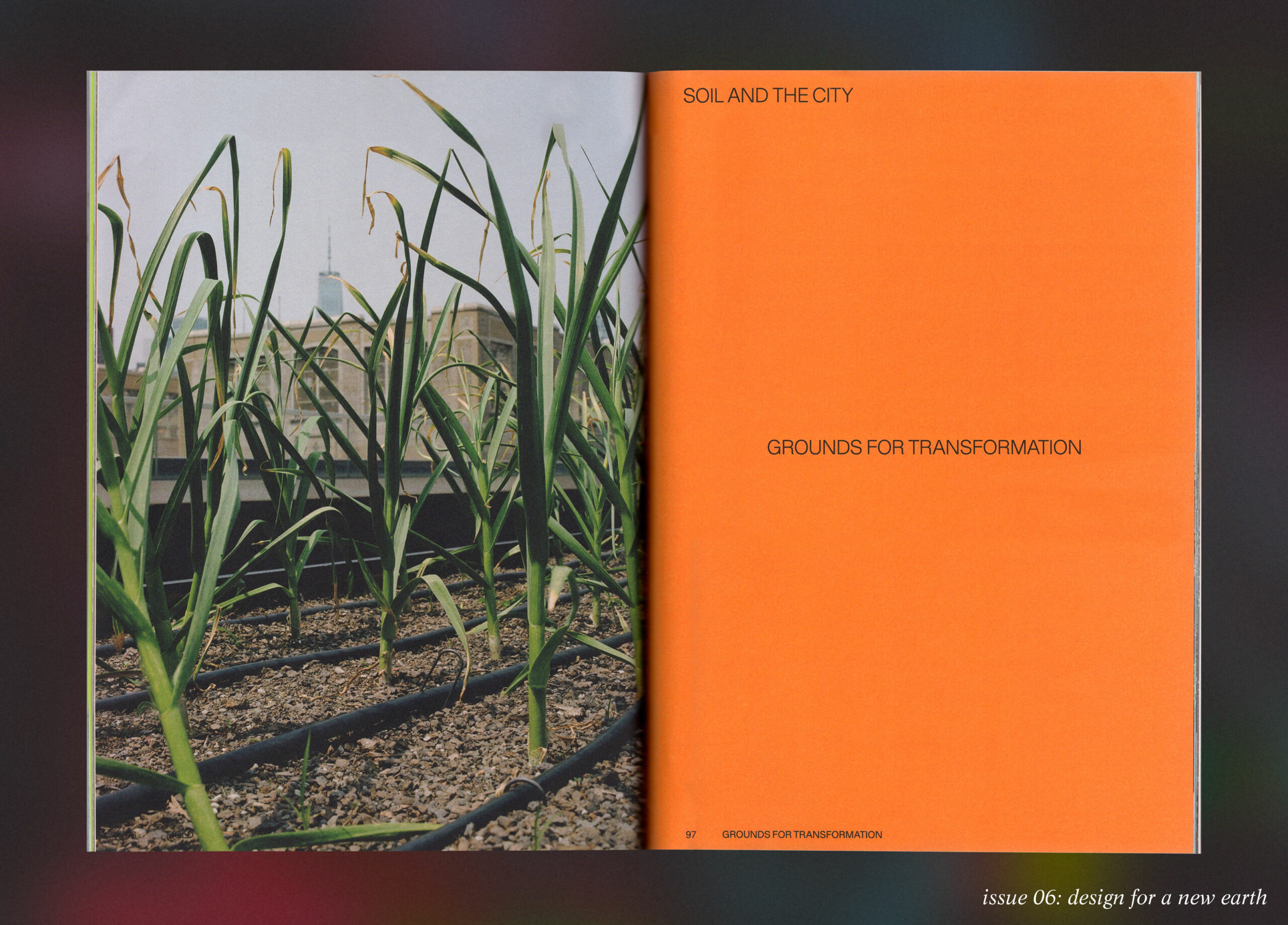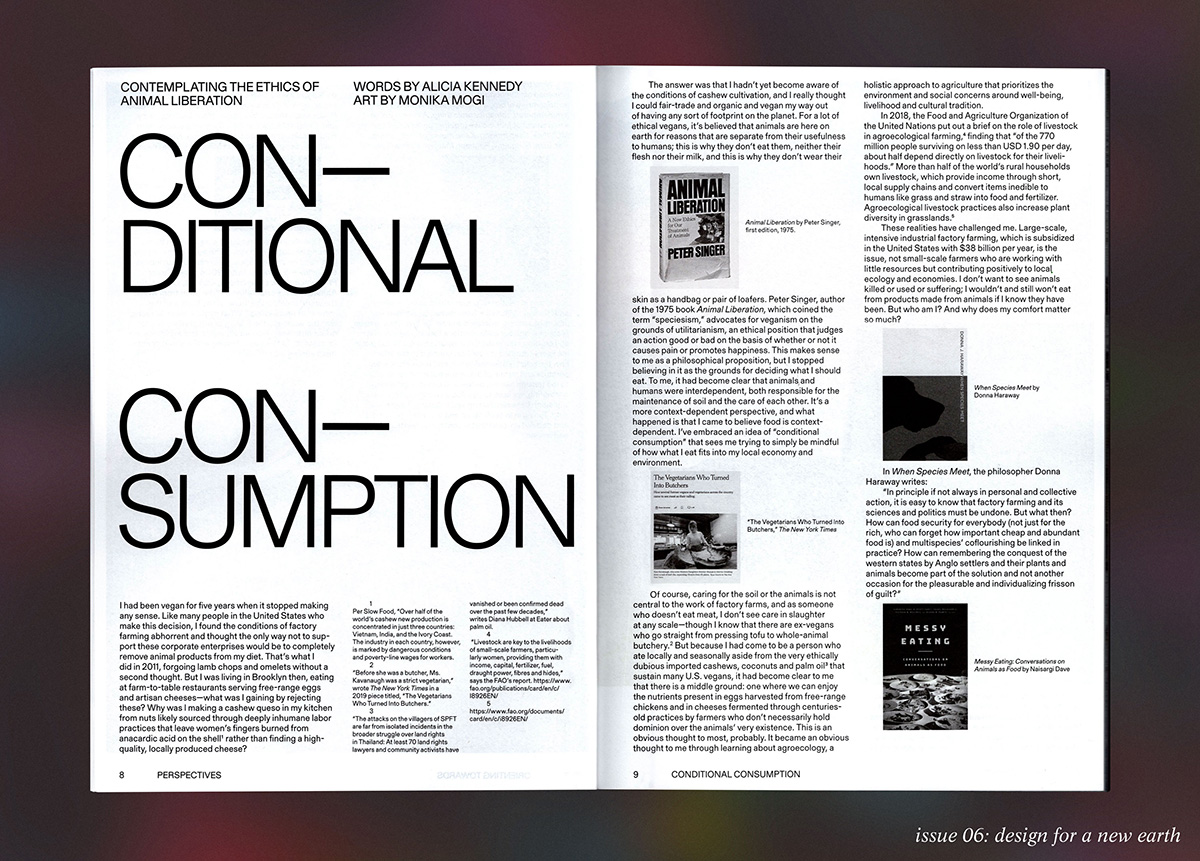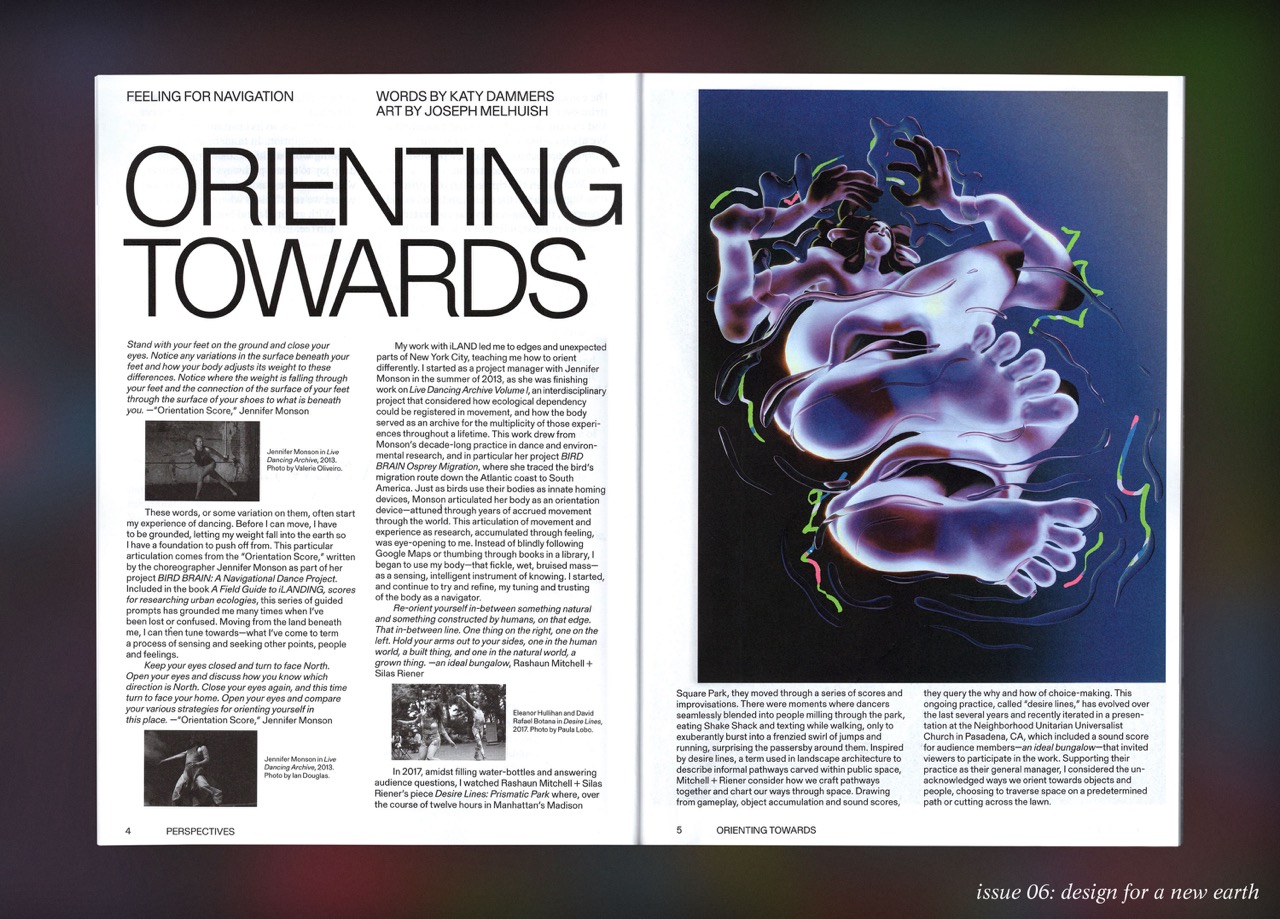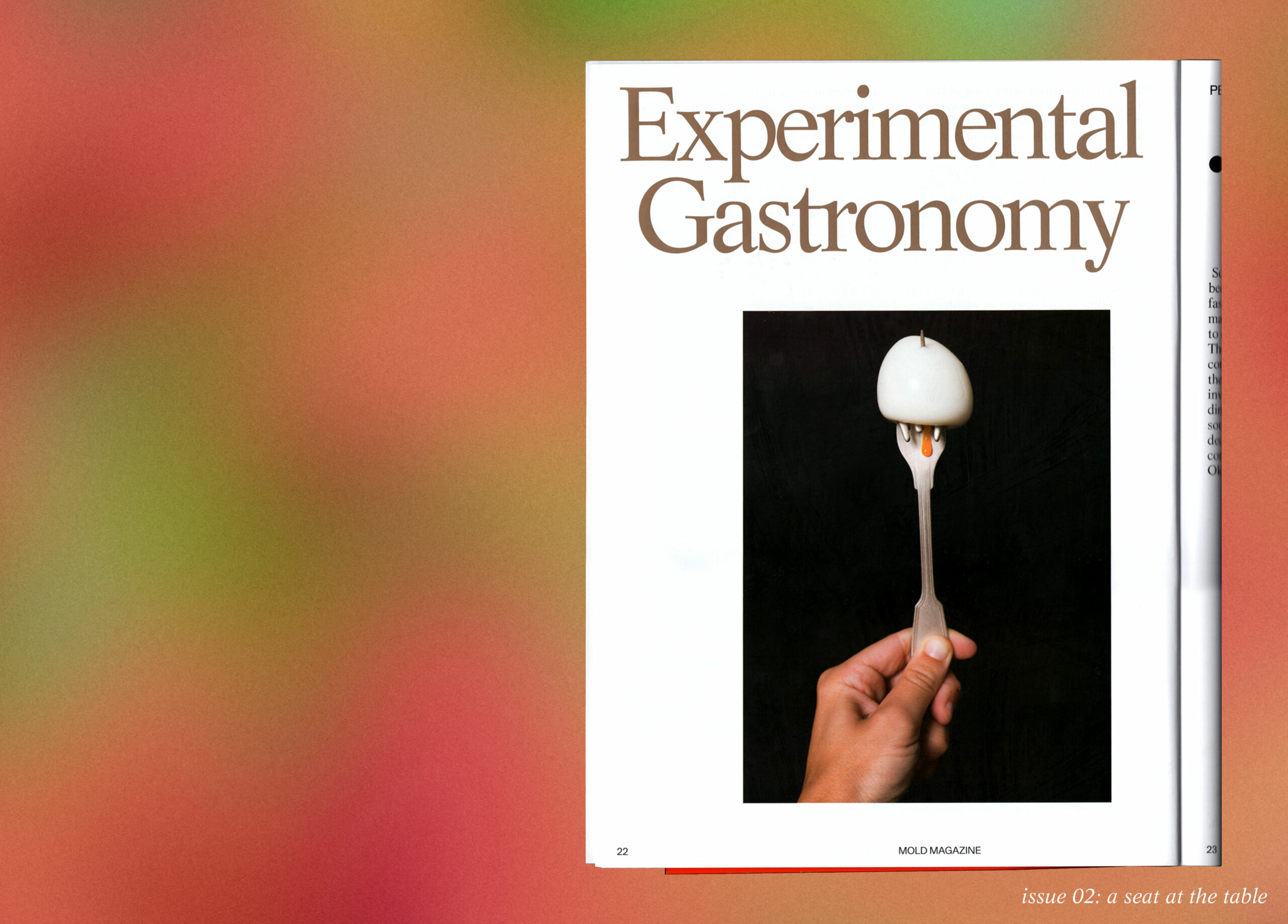This story is part of MOLD Magazine: Issue 04, Designing for the Senses. Order your copy of the full issue here.
Designing food for visual impact is appealing in part because it creates an impression before, or without the need for, introduction into the body through consumption. It is also easy to reproduce mechanically—for portfolios, press coverage and Instagram. Phenomena and philosophies like crossmodalism, an offshoot of experimental psychology that studies multisensory perception, can imbue food work with a gee-whiz factor, but given all the other issues related to food—climate change, species loss, food sovereignty, public health—work that centers these philosophies can lack depth.
How is it possible to do good design work with food, that is sensorially engaging and even delightful, without being flimsy or flip? Fortunately, the grounding answer lies in flavor itself—a phenomenon which naturally and fluidly connects the bigger, systemic aspects of food with its personal, visceral and psychological aspects.
The central dogma of flavor is: flavor is the combination of taste and smell. The mode of smell that feeds into flavor is retronasal olfaction, smell that we experience from the food in our mouths while we are eating it. Taste and smell are chemical senses, which means that we express receptors on our tongues and in our nasal cavities that bind with certain molecules and then send signals to the brain. Taste and smell are the result of our brain’s interpretation of the signals sent in response to a particular set of molecules, and flavor is the psychological integration of the brain’s patterns of taste and smell, with accessory information from the other senses.
Or, more simply: molecule -> taste bud/olfactory receptor -> signal to brain -> neural activation-> taste and smell image -> flavor.
Molecules bind with receptors, which initiate brain activity, which is interpreted as flavor.
Examined this way, experiencing flavor is a very intimate-feeling, interior process. The receptors and the brain play an outsized role. The mechanics of what the brain does to process receptor signals into encoded perceptions, and those specific encoded perceptions themselves, are the concepts most begging for exploration.
But if our interest is in the human experience in the world, this central process is more usefully conceptualized as a conduit, connecting huge phenomena attached on either side.

The brain side: what processes are recruited in creating the perception of flavor? What roles do emotion and memory play, and how do their roles in flavor connect to the other functions they serve for humans?
The molecule side: what molecules can cause us to sense flavor? Why those molecules? Where do they come from? In their sensable form, were they made by chemical or biological processes? What processes, on a chemical, biochemical, ecological, or evolutionary scale, caused them to be made? What roles do they or their precursors play in the site in which they were created? What other molecules are they related to? Do those molecules have any effect on us?
ON THE TOMATO
A tomato has sour, sweet, umami, fruity, green, vegetal, spicy, fruity, floral, peachy, nutty, minty, earthy, and molasses-y flavor qualities. Framed within the confines of perception, the tomato as a sensory entity is a grouping of molecules that interact with taste and smell receptors, send signals to the brain, and create the sensory precepts of “sour,” “umami,” “vegetal,” “floral,” “fruity” and others, as well as an overall gestalt of “tomato.”
TOMATOES ON THE BRAIN
Volatile molecules from the tomato interact with around 400 types of olfactory receptors expressed by humans on the surface of olfactory neurons in the olfactory epithelium, a tissue layer on the top wall of the nasal cavity. Each of the volatile molecule types will interact with several different types of receptors, and many receptors will bind to several different types of tomato volatiles. This binding generates signals that pass through the spherical glomeruli of the olfactory bulb in the brain as spatial patterns of activation, what neuroscientist Gordon Shepherd calls “odor images”. [Editor’s Note: See Dr. Shepherd’s piece on the science of tasting wine in this issue.] Odor images are processed by matching previously-experienced odor images in a pattern-recognition process not unlike the way we recognize faces by visual recall. This process recruits memory systems, emotional circuits and language to arrive at conscious flavor perception. Unlike other senses like hearing or vision, learned emotional connections to flavor are part of its conscious perception. Without processing emotional memory in the amygdala, humans can’t describe or recall odors.
Eating a tomato causes molecules to bind with receptors, generating spatial patterns of activation in the olfactory bulb, which are passed through emotion- and memory-processing brain structures such as the hippocampus, amygdala and neocortex before they become conscious perception. As you recognize the flavor of the tomato, you are recalling and reliving memories of eating tomatoes: of your grandmother slicing up tomatoes on a plate in August to eat with olive oil, salt and basil; of your grandfather taking you into a tomato field and letting you pick one off the vine; of the sensational tomatoes your stepfather grows in the back garden. You experience the flavor of the tomato, and you also re-experience the tomatoes that have been part of your personal history and your connections to the people around you.
Flavor is a personal, interior sensory phenomenon. But these irrevocable bonds to emotion and memory highlight how it is also part of the self-conceptualization that ties to cultural identity, passed through and symbolically consumed as food. Cuisine is one of the most potent ways that cultural groups perform and define themselves and their history, and the flavorful process of eating is inextricably tied up with the emotion and memory that gives cuisine cultural weight and meaning on the one hand and personal affectivity on the other.
THE MOLECULAR TOMATO
The molecular side of the flavor equation has roots that are similarly far-reaching. You eat a tomato and molecules of glutamic acid, malic acid, sugars, cis-3-hexenal, 1-penten-3-one, ionone, damascenone, 6-methyl-5-hepten-2-one, geranylacetone, 3-methylbutanal, phenylacetaldehyde, methyl salicylate, guaiacol, and 3-methylbutanol diffuse out of its flesh and bind to receptors on your tongue and nasal cavity. This binding will eventually trigger the previously described cascade of emotion, memory and pattern recognition that allows you to perceive the flavor of the tomato. But millions of years before that could ever happen, a human ancestor had to develop the ability to create and wire up those olfactory receptors, an ability that was selected for and retained over millions of years of evolution. Humans have about 1,000 olfactory receptor genes, 400 of which are in use, comprising 1-2% of the genome. Over long epochs with a constant background rate of DNA mutation, we kept these 400 receptor genes, and now we can experience the flavor of beta-ionone (with a violety, raspberry, woody freesia aroma), cis-3-hexenal (the distinctive “cut grass” aroma, green, sharp and fruity), and 6-methyl-5-hepten-2-one (which has an appley, grassy, vegetal, citrusy quality), as well as the emotion and memory cascade triggered by and bound up in their perception and the ties to history and culture those cascades enhance.
The tomato you ate, itself, went through long stretches of evolution to develop those volatiles in the first place: by natural selection, then artificial selection by Quechua, Pueblo and Mexica people (among others) in stretches of the Americas, then development into what might be called “heirloom” varieties into the early 20th century, then into a basically industrial product optimized for pigmentation, transportability and uniform shape—the tomato you eat in 2019 was shaped and the ability to produce these sensory-active molecules was retained. Along the way, and in plants that were kind of like a tomato, but not yet a tomato, these volatiles were produced through different enzymatic pathways. Their positive effect on the plant, the fitness for its niche that they gave it, were significant enough that retaining the ability to produce them became a selection pressure throughout their ongoing evolutionary process.

PLANT STRESS
Many of the smellable, volatile molecules in tomatoes and other plants are secondary or specialized metabolites, molecules produced by an organism that don’t interact with the basic life processes of creating energy for cells or reproduction, but enhance the organism’s ability to do so in their ecological niche.
Molecules that are, to us, flavor molecules, have multiple purposes, evolved to protect against drought or sunlight, act as antifungals and antibacterials, or signal to or poison animals, insects, and other plants. Through the messy random walk that is evolution, many have several functions for the plant.
Often, the plant produces more of these molecules when under the stress conditions that they have evolved to protect against. It makes sense—why invest a lot of metabolically expensive carbon in building up defenses you might not even need? Plants that experience drought or intense ultraviolet-laden sunlight; the incursion of fungi, insects or herbivores; or competition from other plants will ramp up their secondary metabolism and pump out more volatile molecules in response. In the plant’s frame of reference, it is engaging the chemical defense and communication necessary to thrive in a biodiverse environment. To us as eaters, the plant exposed to greater biodiversity and stress makes more flavor. The tomato you ate reddened in response to being illuminated by sunlight and developed grassy notes from cis-3-hexenal in response to the disruption of its skin and flesh, to warn plants nearby that something that likes munching on them is close. The plant’s response to interacting with other plants and animals and a varied environment is tastable.
PLANT METABOLISM
Flavorful molecules aren’t just reflective of the environment and life of the plant. The biochemical mechanisms of their synthesis also yoke them to concentrations of unflavored precursor molecules. Metabolism, the production of diverse biomolecules, is often described as employing pathways. Genes code for proteins, and most of these proteins act on other molecules as enzymes, transforming them. Molecule “X” might be passed through 5 or 6 different enzymes, each of which decorate, or strip, or cleave it in some way, yielding a new molecule which floats around inside the cell until it is acted on by another enzyme. Most organisms have a highly conserved primary metabolism—a set of enzymes, precursors and products laid down at the time of the universal ancestral cell, the progenitor to all three current domains of life, around 3.5 billion years ago. Some common features of primary metabolism are synthesizing amino acids or creating usable energy in the form of ATP through the Krebs cycle.
To make specialized metabolites—materials like collagen, lignin, cellulose, starch, tannins, keratin, melanin, caffeine, morphine, THC, carotenoids, vitamins, lactic acid, pigments, terpenes, phenylpropenes, esters, norisoprenoids and waxes—organisms don’t build up a bunch of carbon atoms from scratch; they siphon off intermediates or products from the primary metabolic processes and alter them, or further alter the molecules they’ve already siphoned off and altered.
Most specialized metabolites belong to one of a few groupings that can be traced down to a particular branching-off point in primary metabolism.
To make its grassy-green aromas like cis-3-hexenal, the tomato doesn’t link up six carbon atoms one by one and dollop an oxygen atom on the end. Rather, it grabs onto one of the many fatty acids produced by primary metabolism (as a form of energy storage related to the Krebs cycle, and as components of the cell membrane) and snips it with a lipoxygenase and a hydroperoxide lyase. To get to geranylacetone, a floral-fruity component of its flavor, the tomato follows the well-trodden path of terpene synthesis, siphoning off acetyl-coenzyme A from the Krebs cycle and altering it through several enzymatic steps to get mevalonic acid then isopentenyl and dimethylallyl diphosphates, which can link up in hundreds of ways to make molecules with citrusy, woody, floral, spicy and herbal flavors, including tomato’s geranylacetone.
This interlinked web of metabolism means seemingly unrelated molecules can have interesting correlations with each other. Very broadly speaking, a plant that is experiencing stress or engaging with a lot of interaction with other species is going to have a more active secondary metabolism than a plant that is less so—so such a plant may have more flavor molecules like terpenes, phenylpropenes and aldehydes, as well as more unsmellable tannins, anthocyanins, carotenoids and alkaloids. Flavor can be a clue to overall deeper chemical complexity, and many of these signalled-but-not-smelt molecules have bioactivities, like antioxidant or anti-inflammatory action, in humans.

ESSENTIAL SIGNALS
Flavor can also tell a more specific story about particularly important molecules. The Beta-ionone and 6-methyl-5-hepten-2-one I mentioned above are both classed as norisoprenoids and are important to your tomato’s flavor—imbuing it with violety, raspberry and appley green aromas, respectively. Norisoprenoids are found in a lot of different fruits and flowers and have a shared synthesis pathway: they’re cleaved directly from carotenoids, too-large-to-smell plant sunscreens and antioxidants made from the same isopentenyl and dimethlallyl phosphate precursors as terpenes, some of which humans convert into vitamin A. Beta-ionone is derived from beta-carotene, and 6-methyl-5-hepten-2-one is derived from lycopene. Lycopene gives tomatoes their red color, but it can’t be converted into vitamin A. Beta-carotene has a more orangey color, less like a picture-perfect ripe tomato, but it can be converted to vitamin A by humans—it is a pro-vitamin A carotenoid.
Here’s the really neat thing: beta-ionone and 6-methyl-5-hepten-2-one are part of the same class, have related precursors and have somewhat related aromas. But beta-ionone, which is made from carotenoids that can provide essential vitamin A, is about 300,000 times MORE aromatically potent to humans than 6-methyl-5-hepten-2-one, which is made from the much-less-useful lycopene. Beta-ionone is aromatically detectable at a concentration of about 7 parts per trillion in tomatoes; 6-methyl-5-hepten-2-one at 2 parts per million. The tomato breeder and flavor expert Harry Klee was one of the first to point out that this is strong evidence that flavor can act not just as a cue for ripeness and tastiness but also the presence of essential nutrients.
To recap, Flavor:
Is mostly taste and smell
Exists in the brain as a composite made from signals created in response to taste- and smell-active molecules binding with receptors
Is processed directly through the brain’s emotion, memory, and language centers
Is a memory- and emotion-based vehicle for culture
Is a sense humans retain 2% of their genome to be able to detect at the receptor level; these genes make up the largest family in the genome
Comes from molecules humans have developed and retained the ability to detect over millions of years of evolution
Senses molecules from the primary and secondary metabolic processes of plants (like terpenes in fruits and herbs), microbes (like esters in yeast fermentation) and animals (like glutamic acid in meat) as well as those molecules transformed by chemistry (like furans in brown butter or guaiacol in smoke)
Senses metabolic molecules that mediate plant-plant and plant-environment interactions and are markers for ecological niches and biodiversity
Senses molecules that are strong cues for essential and useful un-smellable phytomolecules like vitamin A
In these guises, flavor is not just a sensory phenomenon but a natural connector and conduit between these often-distant areas of food systems and of human life on the planet. History is flavor. Culture is flavor. Evolution is flavor. Nutrition is flavor. Biodiversity is flavor. Ecology is flavor. Place is flavor. Economics is flavor. Climate change is flavor. Deal with food and flavor in one of these areas and there will be visceral differences rippling through the network, detectible in others.


